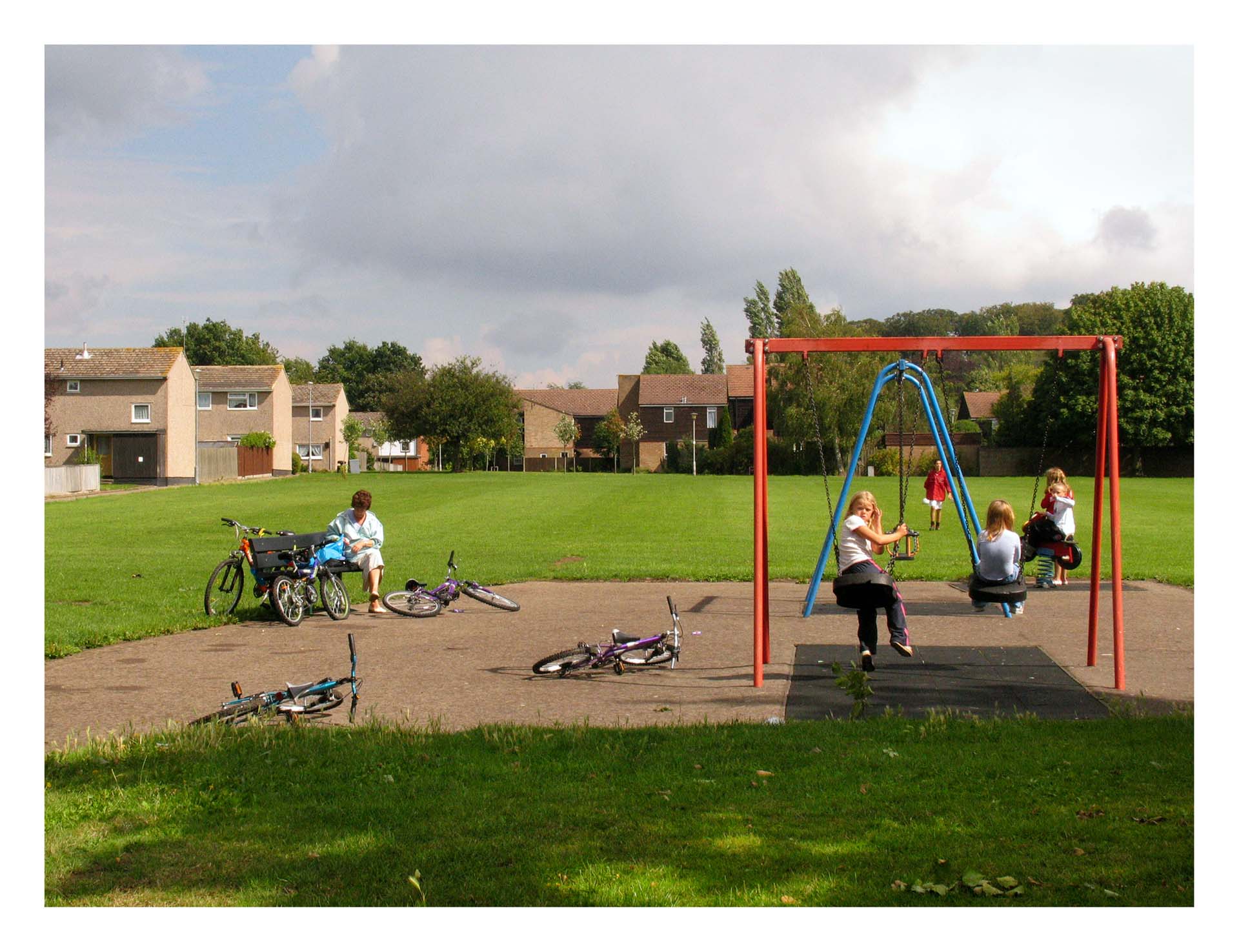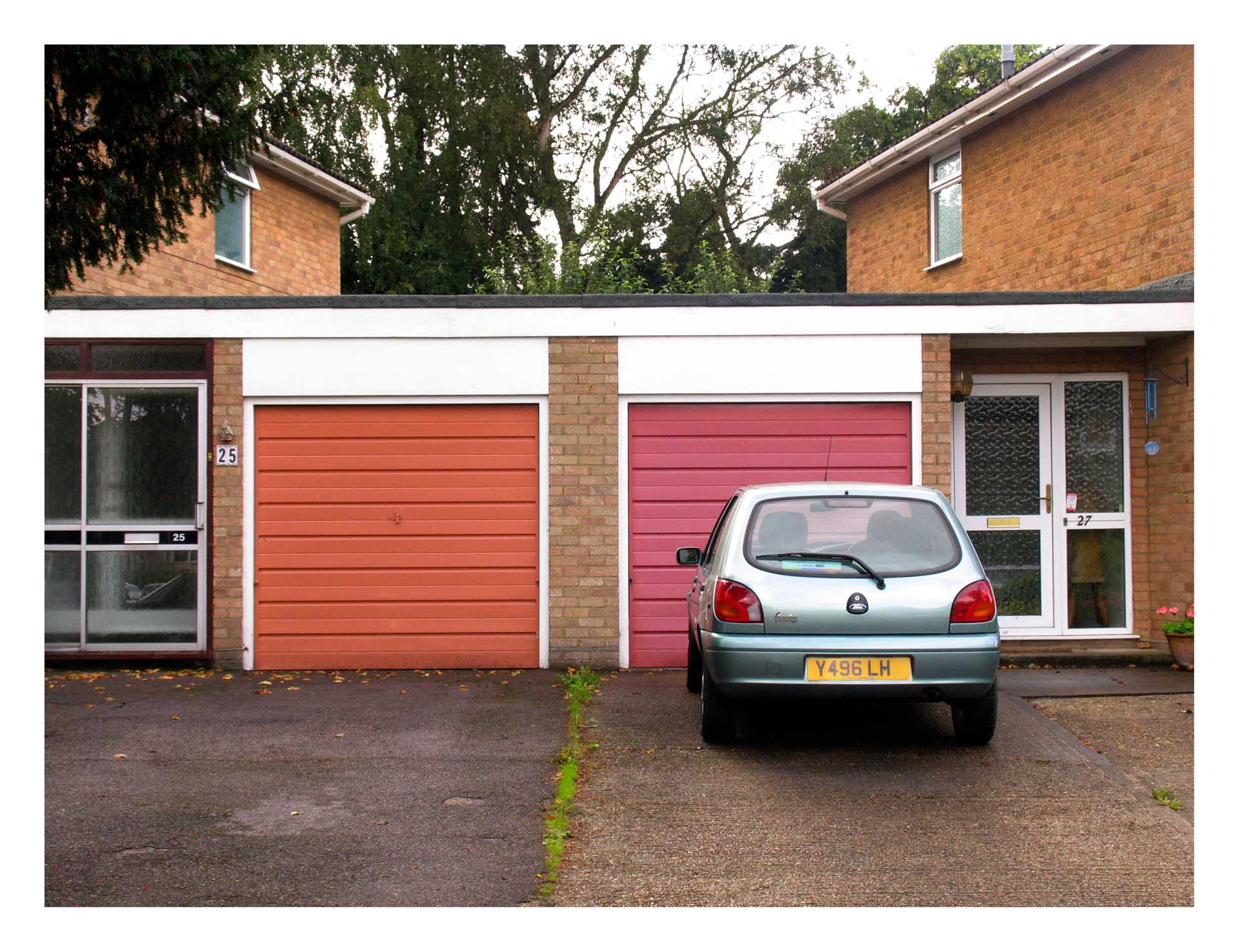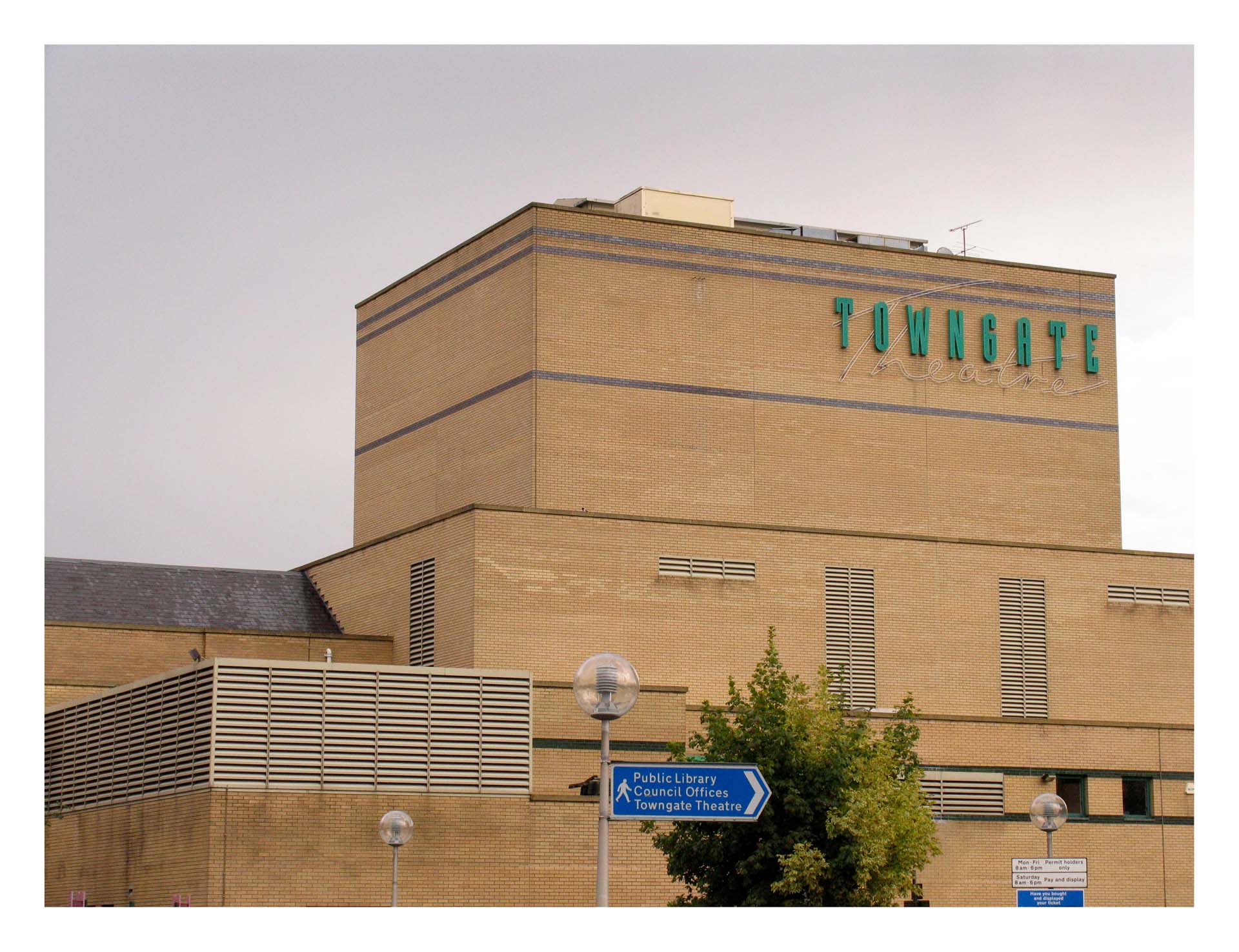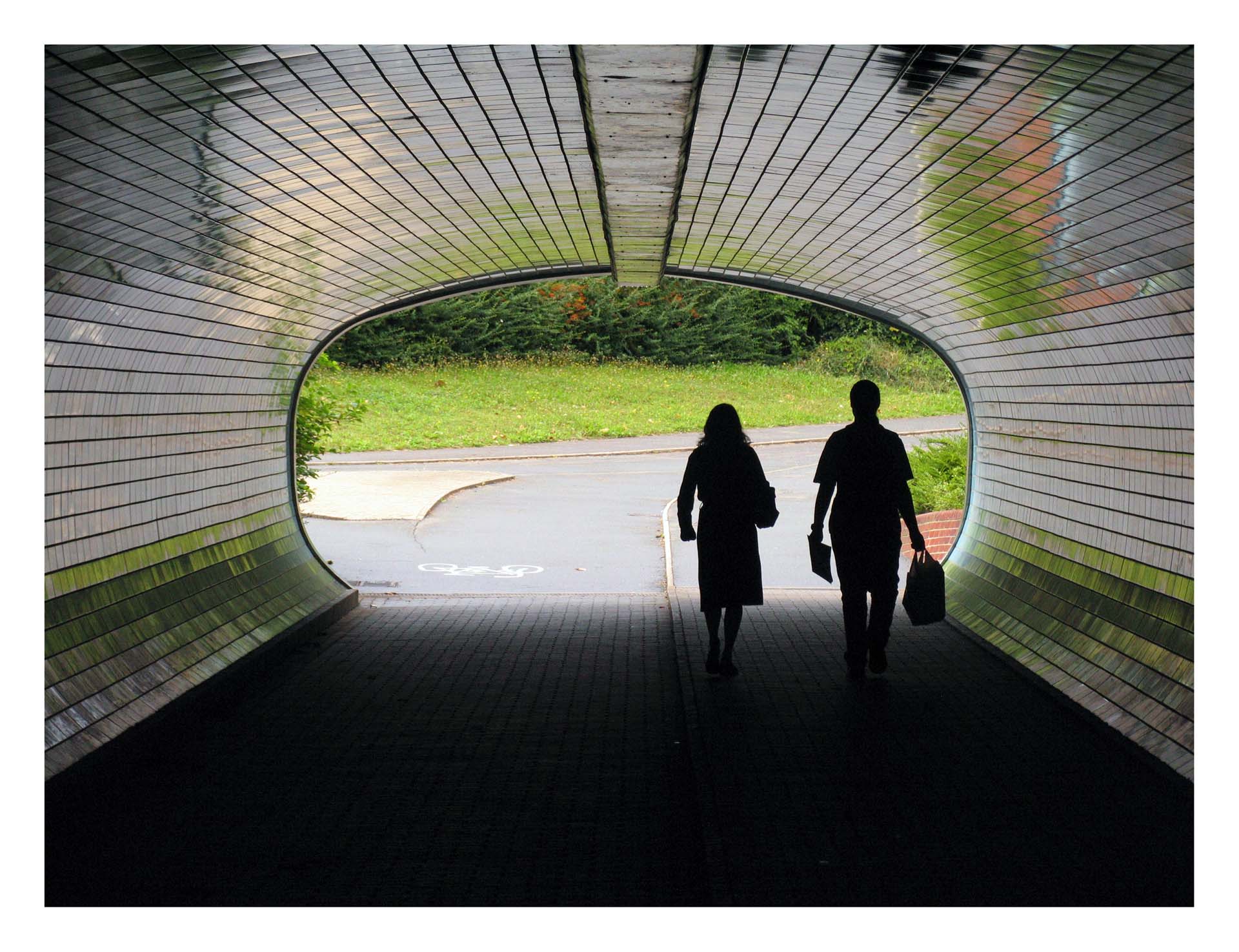
















Vida Orbital
2004 / fotografia digital / impressió amb pigments minerals
Un projecte fotogràfic documental sobre les ciutats satèl·lit de Londres que es coneixen com new towns. La metròpoli i altres ciutats angleses varen quedar arrasades pels bombardejos de l'aviació alemanya en la Segona Guerra mundial. Lesnew townssón les ciutats que es varen planificar a l'anell orbital de Londres finalitzada la guerra i que foren construïdes entre els anys 50 i 70 del passat segle. Els urbanistes i arquitectes varen reprendre el model del moviment Garden-City i el tractat d’Ebenezer HowardGarden cities of tomorow(1902). Bàsicament consistia a unir els avantatges de la nova vida urbana i la nova societat industrial amb el millor del món rural i la vida tradicional en el camp. Una utopia que anava més enllà i implicava un nou ordre social i econòmic, inspirat en idees comunitaristes i de progrés social. Les new townsdel segon terç del s. XX es varen aixecar seguint en gran part aquests principis, però a partir dels anys 80 es varen privatitzar les corporacions i es diluiren alguns dels objectius socials. Viure a la ciutat però com si s'estigués al camp forma ja part de l'imaginari occidental i s'ha convertit en l'aspiració de les classes mitjanes urbanes. Una mirada curiosa a la naturalesa artificializada de la societat postindustrial i els seus ideals de felicitat. ================Un proyecto fotográfico documental sobre las ciudades satélite de Londres conocidas comonew towns. La metrópoli y otras ciudades inglesas quedaron arrasadas por los bombardeos de la aviación alemana en la 2ª Guerra Mundial. Las new towns son las ciudades que se planificaron en el anillo orbital de Londres finalizada la guerra y que fueron construidas entre los años 50 y 70 del siglo pasado. Los urbanistas y arquitectos retomaron el modelo del movimiento Garden-City y el tratado de Ebenezer Howard "Garden cities of tomorow" (1902). Básicamente consistía en unir las ventajas de la nueva vida urbana y la nueva sociedad industrial, con lo mejor del mundo rural, y la vida tradicional en el campo. Una utopía que iba más allá e implicaba un nuevo orden social y económico, inspirada en ideas comunitaristas y de progreso social. Las new townsdel 2º tercio del s. XX se levantaron siguiendo en gran parte estos principios, pero a partir de los años 80, se privatizaron las corporaciones, diluyéndose algunos de los objetivos sociales. Vivir en la ciudad pero como si se estuviera en el campo forma ya parte del imaginario occidental y se ha convertido en la aspiración de las clases medias urbanas. Una mirada curiosa a la naturaleza artificializada de la sociedad postindustrial y sus ideales de felicidad.
================A photographic documentary about London’s satellite cities, known as "new towns". During World War II London and other English cities were devastated by the German air force’s bombing. The "new towns" are the cities that were planned in the orbital ring around London after the War, and built between the 1950s and 1970s. Town planners and architects returned to the model of the Garden-City movement and the guidelines of Ebenezer Howard's treatise "Garden cities of tomorrow” (1902). Basically, this consisted of combining the advantages of the new urban lifestyle and the new industrial society, with the best aspects of the rural world and traditional life in the countryside. A utopia that went even further and implied a new social and economic order inspired by communitarian ideals and social progress. The "New Towns" of the second third of the 20th century were built following these principles to a great extent, but from the 80s on, the corporations were privatized, thereby watering down some of the social objectives. Living in the city as if one was in the countryside already forms part of Western mythology and has become an aspiration for the urban middle-classes. An inquiring look at the artificial nature of the post-industrial society and its ideals of happiness.
2004 / fotografia digital / impressió amb pigments minerals
Un projecte fotogràfic documental sobre les ciutats satèl·lit de Londres que es coneixen com new towns. La metròpoli i altres ciutats angleses varen quedar arrasades pels bombardejos de l'aviació alemanya en la Segona Guerra mundial. Lesnew townssón les ciutats que es varen planificar a l'anell orbital de Londres finalitzada la guerra i que foren construïdes entre els anys 50 i 70 del passat segle. Els urbanistes i arquitectes varen reprendre el model del moviment Garden-City i el tractat d’Ebenezer HowardGarden cities of tomorow(1902). Bàsicament consistia a unir els avantatges de la nova vida urbana i la nova societat industrial amb el millor del món rural i la vida tradicional en el camp. Una utopia que anava més enllà i implicava un nou ordre social i econòmic, inspirat en idees comunitaristes i de progrés social. Les new townsdel segon terç del s. XX es varen aixecar seguint en gran part aquests principis, però a partir dels anys 80 es varen privatitzar les corporacions i es diluiren alguns dels objectius socials. Viure a la ciutat però com si s'estigués al camp forma ja part de l'imaginari occidental i s'ha convertit en l'aspiració de les classes mitjanes urbanes. Una mirada curiosa a la naturalesa artificializada de la societat postindustrial i els seus ideals de felicitat. ================Un proyecto fotográfico documental sobre las ciudades satélite de Londres conocidas comonew towns. La metrópoli y otras ciudades inglesas quedaron arrasadas por los bombardeos de la aviación alemana en la 2ª Guerra Mundial. Las new towns son las ciudades que se planificaron en el anillo orbital de Londres finalizada la guerra y que fueron construidas entre los años 50 y 70 del siglo pasado. Los urbanistas y arquitectos retomaron el modelo del movimiento Garden-City y el tratado de Ebenezer Howard "Garden cities of tomorow" (1902). Básicamente consistía en unir las ventajas de la nueva vida urbana y la nueva sociedad industrial, con lo mejor del mundo rural, y la vida tradicional en el campo. Una utopía que iba más allá e implicaba un nuevo orden social y económico, inspirada en ideas comunitaristas y de progreso social. Las new townsdel 2º tercio del s. XX se levantaron siguiendo en gran parte estos principios, pero a partir de los años 80, se privatizaron las corporaciones, diluyéndose algunos de los objetivos sociales. Vivir en la ciudad pero como si se estuviera en el campo forma ya parte del imaginario occidental y se ha convertido en la aspiración de las clases medias urbanas. Una mirada curiosa a la naturaleza artificializada de la sociedad postindustrial y sus ideales de felicidad.
================A photographic documentary about London’s satellite cities, known as "new towns". During World War II London and other English cities were devastated by the German air force’s bombing. The "new towns" are the cities that were planned in the orbital ring around London after the War, and built between the 1950s and 1970s. Town planners and architects returned to the model of the Garden-City movement and the guidelines of Ebenezer Howard's treatise "Garden cities of tomorrow” (1902). Basically, this consisted of combining the advantages of the new urban lifestyle and the new industrial society, with the best aspects of the rural world and traditional life in the countryside. A utopia that went even further and implied a new social and economic order inspired by communitarian ideals and social progress. The "New Towns" of the second third of the 20th century were built following these principles to a great extent, but from the 80s on, the corporations were privatized, thereby watering down some of the social objectives. Living in the city as if one was in the countryside already forms part of Western mythology and has become an aspiration for the urban middle-classes. An inquiring look at the artificial nature of the post-industrial society and its ideals of happiness.